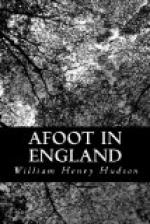Who would have thought to find a tree-planter in the wheatear, the bird of the stony waste and open naked down, who does not even ask for a bush to perch on?
It then occurred to me that in every case where I had observed a clump of elder bushes on the bare downside, it grew upon a village or collection of rabbit burrows, and it is probable that in every case the clump owed its existence to the wheatears who had dropped the seed about their nesting-place. The clump where I had sought a shelter from the storm was composed of large old dilapidated-looking half-dead elders; perhaps their age was not above thirty or forty years, but they looked older than hawthorns of one or two centuries; and under them the rabbits had their diggings—huge old mounds and burrows that looked like a badger’s earth. Here, too, the burrows had probably existed first and had attracted the wheatears, and the birds had brought the seed from some distant bush.
Crouching down in one of the big burrows at the roots of an old elder I remained for half an hour, listening to the thump-thump of the alarmed rabbits about me, and the accompanying hiss and swish of the wind and sleet and rain in the ragged branches.
The storm over I continued my rambles on Whitesheet Hill, and coming back an hour or two later to the very spot where I had seen and followed the wheatear, I all at once caught sight of a second bird, lying dead on the turf close to my feet! The sudden sight gave me a shock of astonishment, mingled with admiration and grief. For how pretty it looked, though dead, lying on its back, the little black legs stuck stiffly up, the long wings pressed against the sides, their black tips touching together like the clasped hands of a corpse; and the fan-like black and white tail, half open as in life, moved perpetually up and down by the wind, as if that tail-flirting action of the bird had continued after death. It was very beautiful in its delicate shape and pale harmonious colouring, resting on the golden-green mossy turf. And it was a male, undoubtedly the mate of the wheatear I had seen at the spot, and its little mate, not knowing what death is, had probably been keeping watch near it, wondering at its strange stillness and greatly fearing for its safety when I came that way, and passed by without seeing it.
Poor little migrant, did you come back across half the world for this—back to your home on Whitesheet Hill to grow cold and fail in the cold April wind, and finally to look very pretty, lying stiff and cold, to the one pair of human eyes that were destined to see you! The little birds that come and go and return to us over such vast distances, they perish like this in myriads annually; flying to and from us they are blown away by death like sere autumn leaves, “the pestilence-stricken multitudes” whirled away by the wind! They die in myriads: that is not strange; the strange, the astonishing thing is the fact of death; what can they tell us




